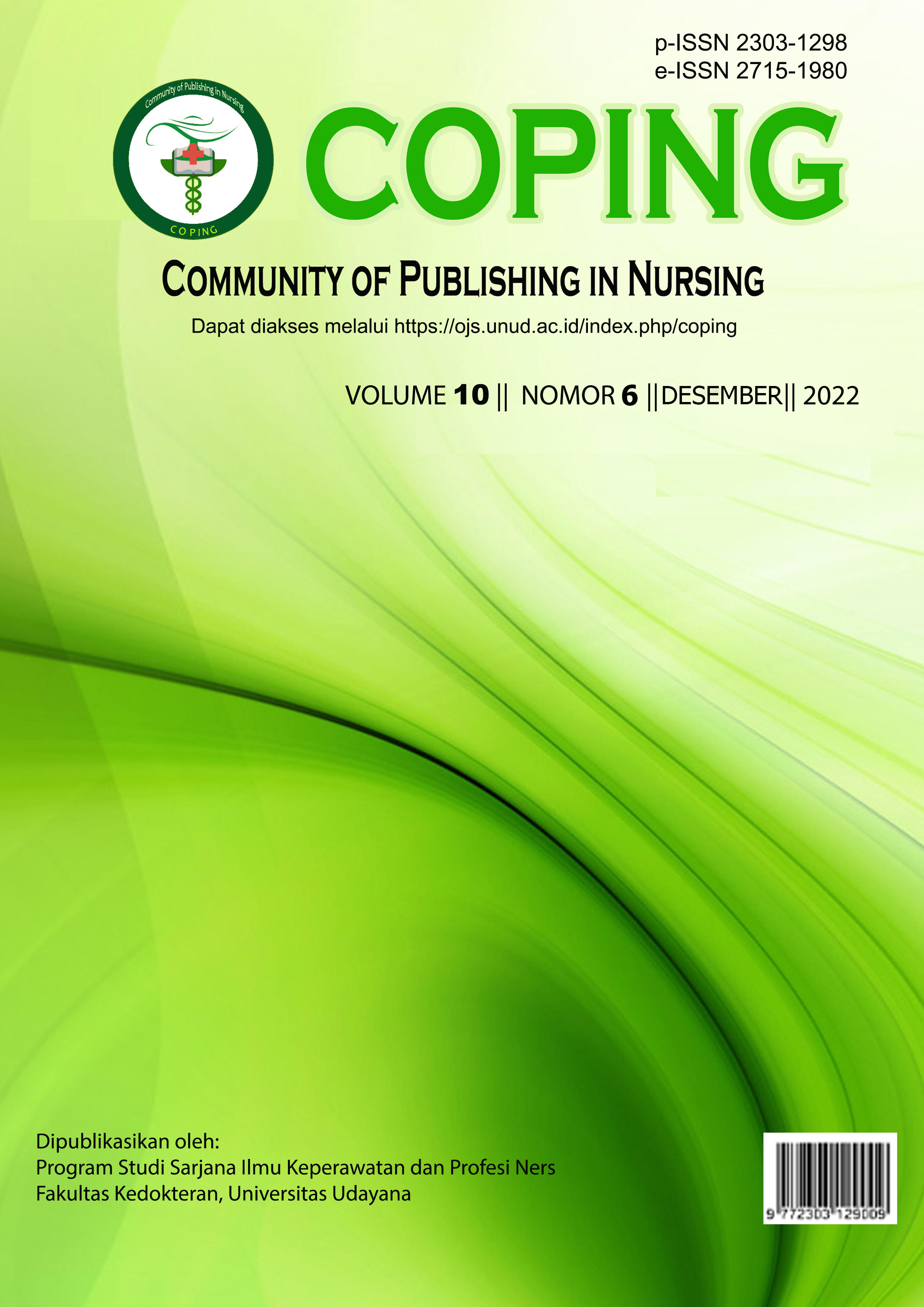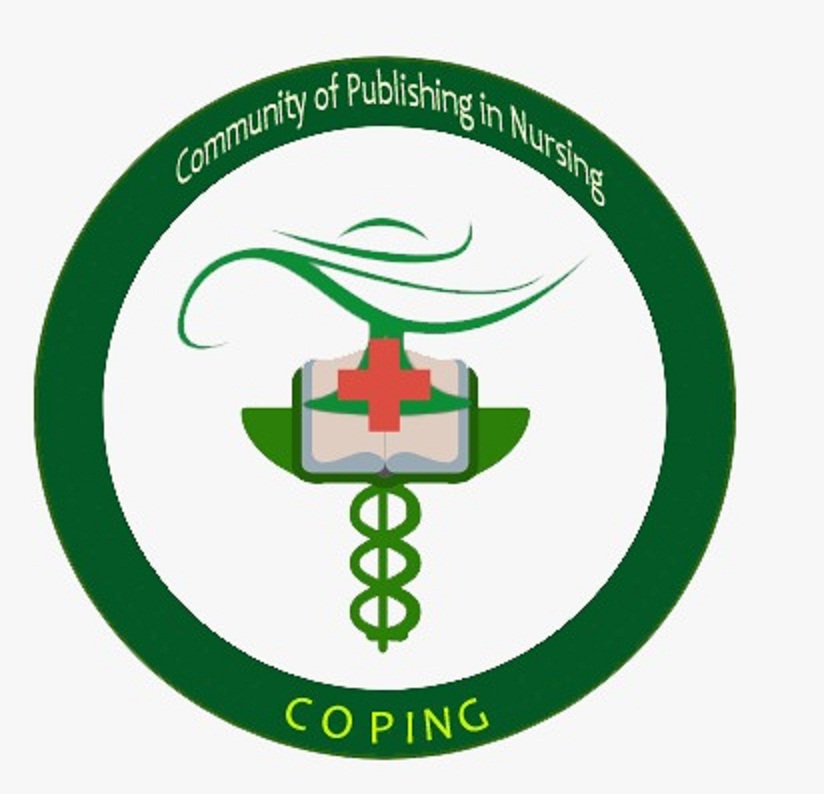PENGETAHUAN DAN KEYAKINAN MAHASISWA KEPERAWATAN TENTANG COMPLEMENTARY AND ALTERNATIVE MEDICINE (CAM)
Abstract
Meningkatnya penggunaan complementary and alternative medicine (CAM) terutama di Indonesia mengakibatkan perlunya tenaga kesehatan untuk memiliki pengetahuan tentang CAM. Pengetahuan dan keyakinan perawat tentang CAM merupakan indikator penting dalam memberikan saran dan pertimbangan kepada pasien yang ingin mencobanya. Penting bagi mahasiswa keperawatan sebagai calon perawat untuk memiliki pengetahuan dan keyakinan yang baik terkait CAM. Adapun tujuan dari studi ini adalah untuk mengidentifikasi dan mencari perbandingan pengetahuan dan keyakinan mahasiswa keperawatan tentang complementary and alternative medicine. Penelitian ini dilakukan di Institut Teknologi dan Kesehatan Bali. Jumlah responden dalam penelitian ini adalah 528 orang yang terdiri dari mahasiswa keperawatan tahun I, II, III, dan IV. Self-administered kuesioner digunakan sebagai instrumen pengumpulan data dalam penelitian ini. Analisis data menggunakan program komputer dengan nilai signifikansi 0,05. Adapun hasil penelitian yang didapatkan adalah diantara 13 modalitas CAM hanya 4 modalitas yang diketahui dengan baik oleh seluruh mahasiswa keperawatan (tahun I, II, III, IV). Modalitas tersebut adalah jamu, yoga, meditasi, dan pijat. Ketika keyakinan mahasiswa keperawatan tentang CAM dikaji, ditemukan bahwa mahasiswa keperawatan di semua tingkatan memiliki sikap positif terhadap CAM. Namun, ada perbedaan yang signifikan dari skor CHBQ antara mahasiswa di setiap tahun studi (p<0,05). Berdasarkan hasil penelitian ini dapat disimpulkan bahwa memasukkan materi tentang CAM ke dalam kurikulum dapat sangat bermanfaat bagi mahasiswa keperawatan karena mereka akan menghadapi para pengguna CAM dalam praktik klinis mereka dan mereka perlu mempertimbangkan hal ini ketika membuat keputusan klinis.
Downloads
References
Balouchi, A., Mahmoudirad, G., Hastings-Tolsma, M., Shorofi, S., Shahdadi, H., & Abdollahimohammad, A. (2018). Knowledge, attitude and use of complementary and alternative medicine among nurses: A systematic review. Complementary Therapies in Clinical Practice. doi:10.1016/j.ctcp.2018.02.008
Fowler, S., & Newton, L. (2006). Complementary and Alternative Therapies: The Nurse’s Role. Journal of Neuroscience Nursing, 38(4), 261-264.
Gershoni, Z., Freud, T., Press, Y., & Peleg, R. (2008). Knowledge and Attitudes of Internists Compared to Medical Students Regarding Acupuncture. The Israel Medical Association journal: IMAJ, 10, 219-222.
Hall, H., Brosnan, C., Frawley, J., Wardle, J., Collins, M., & Leach, M. (2017). Nurses’ communication regarding patients’ use of complementary and alternative medicine. Collegian. doi: http://dx.doi.org/10.1016/j.colegn.2017.09.001
Hidayah, N., & Nisak, R. (2018). Buku Ajar Terapi Komplementer untuk Mahasiswa Keperawatan (Evidence Base Practise) Yogyakarta: Samudra Biru.
Horneber, M., Bueschel, G., & Dennert, G. (2012). How many cancer patients use complementary and alternative medicine: A systematic review and metaanalysis. Integr Cancer Ther, 3, 187–203.
LaForce, C., Scott, C., Heitkemper, M., Cornman, J., Lan, M., Bond, E., & Swanson, K. (2010). Complementary and Alternative Medicine (CAM) Competencies of Nursing Students and Faculty: Results of Integrating CAM Into the Nursing Curriculum. J Prof Nurs, 26(5), 293-300. doi:10.1016/j.profnurs.2010.03.003
Lie, D., & Boker, J. (2004). Development and validation of the CAM Health Belief Questionnaire (CHBQ) and CAM use and attitudes amongst medical students. BMC Medical Education, 4(2), 9.
MacArtney, J., & Wahlberg, A. (2014). The problem of complementary and alternative medicine use today: Eyes half closed? Qual Health Res, 1, 114–123.
Menniti-Ippolito, F., Gargiulo, L., & Bologna, E. (2002). Use of unconventional medicine in Italy: A nation-wide survey. Eur J Clin Pharmacol, 1, 61-64.
NCCAM. (2021, April 2021). Complementary, alternative, or integrative health: What’s in a name? Retrieved from https://www.nccih.nih.gov/health/complementary-alternative-or-integrative-health-whats-in-a-name
Pengpid, S., & Peltzer, K. (2018). Utilization of traditional and complementary medicine in Indonesia: Results of a national survey in 2014–15. Complementary Therapies in Clinical Practice, 33, 156-163. doi:https://doi.org/10.1016/j.ctcp.2018.10.006
Ramadianto, A., Andrian, C., Lenardi, M., Surya, R., Cheng, W., & Rahmawati, F. (2015). Knowledge, Perception, and Attitude of Universitas Indonesia Medical Students toward Complementary and Alternative Medicine J Asian Med Stud Assoc, 4(1), 4-13.
Rampes, H., & Pilkington, K. (2009). Complementary and alternative therapies. In I. Norman & I. Ryrie (Eds.), The Art and Science of Mental Health Nursing. UK: McGraw Hill.
Red, R., Steel, A., Wardle, J., Trubody, A., & Adams, J. (2016). Complementary medicine use by the Australian population: a critical mixed studies systematic review of utilisation, perceptions and factors associated with use. BMC Complement Altern Med, 16. doi:https://doi.org/10.1186/s12906-016-1143-8
Roedler, D., Vincent, A., Elkin, P., Loehrer, L., Cha, S., & Bauer, B. (2006). Physicians’ Attitudes Toward Complementary and Alternative Medicine and Their Knowledge of Specific Therapies: A Survey at an Academic Medical Center. eCAM, 3(4), 495-501. doi:10.1093/ecam/nel036
Shmueli, A., Igudin, I., & Shuval, J. (2011). Change and stability: Use of complementary and alternative medicine in Israel: 1993, 2000 and 2007. Eur J Public Health, 2, 254–259.
Siswanto, B., Setiawati, S., & Riyanto, O. (2022). Juridical Aspects Of Complementary Traditional Medicine In Indonesia. International Journal of Educational Research & Social Sciences, 3(1), 468-475. doi:https://doi.org/10.51601/ijersc.v3i1.298
Skovgaard, L., Nicolajsen, P., & Pedersen, E. (2013). Differences between users and non-users of complementary and alternative medicine among people with multiple sclerosis in Denmark: A comparison of descriptive characteristics. Scand J Public Health, 5, 492–499.
Sparber, A. (2001). State Boards of Nursing and Scope of Practice of Registered Nurses Performing Complementary Therapies. Online Journal of Issues in Nursing, 6(3).
Tabish, S. (2008). Complementary and Alternative Healthcare: Is It Evidence-based ? . International Journal of Health Sciences, 2(1), 5-9.
Trail-Mahan, T., & Ling Mao, C. (2013). Complementary and Alternative Medicine: Nurses’ Attitudes and Knowledge. Pain Management Nursing, 14(4), 277-286. doi:http://dx.doi.org/10.1016/j.pmn.2011.06.001
Walker, B., Armson, A., Hodgetts, C., Jacques, A., Chin, F., Kow, G., . . . Wright, A. (2017). Knowledge, attitude, influences and use of complementary and alternative medicine (CAM) among chiropractic and nursing students. Chiropractic & Manual Therapies, 25(29), 8. doi:10.1186/s12998-017-0160-0
Yakoot, M. (2013). Bridging the gap between alternative medicine and evidence-based medicine. J. Pharmacol. Pharmacother., 4, 83-85.

This work is licensed under a Creative Commons Attribution-NonCommercial 4.0 International License.







